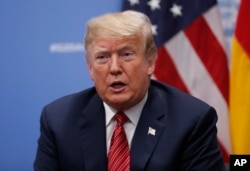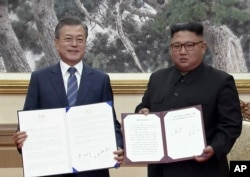Following the Group of 20 (G-20) meeting in Argentina this past weekend, U.S. President Donald Trump said that he not only was looking forward to a possible meeting with North Korean leader Kim Jong Un in early 2019, but also supported a trip to Seoul by Kim to meet with South Korean President Moon Jae-in, possibly before the end of the year.
Yoon Young-chan, the presidential secretary for public affairs told reporters, “The two leaders agreed that Chairman Kim Jong Un’s visit to Seoul would provide additional momentum to their joint efforts to establish peace on the Korean Peninsula.”
Assistant Professor at Kyongnam University Institute for Far Eastern Studies, Cho Jin-goo adds Kim coming to Seoul would be meaningful, allowing him to speak directly to South Koreans as Moon did in September while in Pyongyang.
“In that sense, it could be a milestone,” he said.
In a White House statement, the administration said that Moon and Trump “agreed on the importance of maintaining vigorous enforcement of existing sanctions to ensure the DPRK understands that denuclearization is the only path to economic prosperity and lasting peace on the Korean Peninsula.”
The DPRK is an abbreviation of the North’s official name, the Democratic People’s Republic of Korea.
Moon told reporters after the G-20 that Trump has “very favorable” views toward Kim and that he “likes him," adding the American president “asked me to tell Chairman Kim that he wants to implement the rest of their agreement together and he will fulfill Chairman Kim's wishes."
Goals for Seoul
It’s unclear what objectives will be achieved when Kim makes the trip south from Pyongyang to Seoul, regardless of whether or not it takes place in the waning days of 2018.
Cho notes that such a trip, the first by a North Korean leader, will be symbolic.
However, “the question remains whether the practical outcome will arise,” says Cho, despite Moon pledging to make the visit take place while in Pyongyang during the third inter-Korean summit held in September.
Nam Sung-wook, professor of Korean Unification, Diplomacy and Security at Korea University, identified three reasons the Moon administration has pursued Kim coming to Seoul before 2019 arrives.
“First of all,” he says, the Moon government wants to improve its approval ratings. “Domestic politics have not been favorable because of the sluggish economy.”
Recently, Moon’s Realmeter approval rating has dropped to 48.4 percent, his lowest level since taking office and marked a steady decline over the past two months when his approval rating soared to over 65 percent following the Pyongyang summit in September.
Nam says a second reason and potential outcome for the visit would be to “convince people that North Korea has changed” and that North Korea and Kim can keep their word. Nam says it may persuade those still holding onto negative views.
Finally, he says, if Moon can hold another meeting before the second Trump - Kim summit, “then inter-Korea relationships can help improve North Korea - United States relationships.”
Ultimately he says whether or not the meeting takes place is now up to Pyongyang.
“From Kim's perspective, he's still doubtful what he can earn from Seoul. Though there is a strong request from Seoul, North Korea will calculate whether this is the best moment to make Kim’s visit,” says Nam.
Prospects for positive outcomes between Trump and Kim
While Nam reiterated that both the South Korean and American presidents saw a Seoul summit as a positive move before a second U.S.-North Korea summit in January or February 2019, the leaders also “reaffirmed the principle that there is no easing sanction at the same time.”
But last month, North Korea said via its official state media it would reconsider building nuclear weapons.
"The improvement of relations (with the United States) and sanctions are incompatible," said the official Korean Central News Agency.
“Because sanctions and punishment are hurting North Korea economically,” Nam expects Pyongyang will attempt to persuade China and Russia to convince the United States to ease sanctions next year.
With regard to a second Trump-Kim summit, U.S. Vice President Mike Pence told NBC News in November, the United States would not require Pyongyang to provide a complete list of nuclear weapons and locations, but that the meeting must produce a concrete plan.
“North Korea cannot reverse the course of discussions because they’ve been stated to the international community… [their desire] to denuclearize. They cannot nullify their statements,” said Cho.
He adds that the second summit should produce more specifics than Singapore meeting last June, “and it seems that President Moon directly persuaded Kim to do so.”
Lee Ju-hyun contributed to this report.












